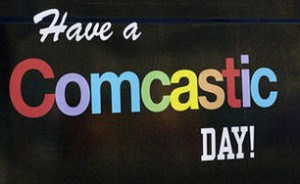
Du Quoin, Ill.
Remember when your cable system delivered 60 basic cable channels with a handful of premium services, none in High Definition? The people of Du Quoin, Ill. do — to this day.
They, along with several other small southern Illinois communities served by Comcast, are living a wired life free from HD programming, cable networks many take for granted, and a quality of service that has diminished as an aging cable system outlives its useful life.
Now the commissioner of Du Quoin has put Comcast’s franchise “on hold” until the cable company updates service for the town’s 6,500 residents.
Commissioner Rex Duncan told the city council last week he’s fed up with Comcast’s lack of interest in delivering even a handful of HD channels to subscribers, even as the company moves channels that used to be part of the basic cable lineup to a new tier that requires the rental of a digital converter box.
Until Comcast decides to invest in upgrades in the area, De Quoin joins the cities of Pinckneyville, Benton and Christopher and the villages of Tamaroa and Buckner in refusing franchise renewal requests from the cable operator.
 Reviewing the lineup in Du Quoin shows subscribers confined to receiving the same number of channels most cities had more than 15 years ago. Not a single HD channel is included. Broadband customers can choose from two promoted packages, one promising “up to” 15Mbps and the other claiming 20Mbps with the PowerBoost feature. But few residents actually see those speeds according to one of our readers.
Reviewing the lineup in Du Quoin shows subscribers confined to receiving the same number of channels most cities had more than 15 years ago. Not a single HD channel is included. Broadband customers can choose from two promoted packages, one promising “up to” 15Mbps and the other claiming 20Mbps with the PowerBoost feature. But few residents actually see those speeds according to one of our readers.
Sid, a lifelong resident of De Quoin, says speeds approaching 7Mbps are more typical, except at night when they drop.
“I don’t think Comcast has changed a thing in southern Illnois in over a decade,” Sid shares. “The company’s cable TV lineup still thinks it’s 1992 — we are lucky we even have broadband.”
Residents have complained regularly to local officials about Comcast’s performance in the region, especially when they compare the service they receive with what residents in nearby Carbondale, the self-styled “capital of southern Illinois” receive.
“I realize southern Illinois is between nothing and nowhere, with large cities like St. Louis and Evansville whole states away, but considering how many people depend on Comcast to get reasonable reception of local stations pretty far out, they do a good business here,” Sid says.
Sid does not expect many upgrades in the near future, either to his cable or broadband service.
“DOCSIS 3? What is that?”


 Subscribe
Subscribe





